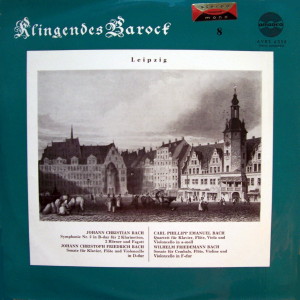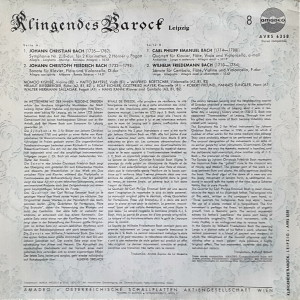 |
1 LP -
Amadeo AVRS 6358
|
 |
|
| LEIPZIG -
Klingendes Barock - 8 |
|
|
|
|
|
| Johann Christian
Bach (1735-1782) |
|
|
| 1. Symphonie
Nr. 2, B-dur, für 2 Klarinetten, 2
Hörner u. Fagott |
10' 13" |
A1 |
| - Allegro ·
Larghetto - Marche - Rondeau
(Allegro) |
|
|
|
|
|
Johann Christoph
Friedrich Bach (1732-1795)
|
|
|
| 2. Sonate für
Klavier, Flöte und Violoncello,
D-dur |
14' 31" |
A2 |
| -
Allegro con spirito · Andante ·
Rondo. Scherzo |
|
|
|
|
|
Carl Philipp
Emanuel Bach (1714-1788)
|
|
|
| 3. Quartett für
Klavier, Flöte, Viola und
Violoncello, a-moll |
12' 13" |
B1 |
- Andantino ·
Largo e sostenuto · Allegro assai
|
|
|
|
|
|
Wilhelm Friedemann Bach
(1710-1784)
|
|
|
| 4.
Sonate für Cembalo, Flöte, Violine
und Violoncello, F-dur |
10' 42" |
B2 |
| -
Largo · Allegretto · Allegro
assai e scherzando |
|
|
|
|
|
| Momoo Kishibe,
Violine (B2) |
Hatto Bayerle,
Viola (B1)
|
|
| Wilfried
Boettcher, Violoncello
(A2, B1, B2) |
Helmut
Riessberger, Flöte (A2,
B1, B2) |
|
| Rolf Eichler,
Klarinette (A1) |
Gottfried Mayer,
Klarinette (A1) |
|
| Robert Freund,
Horn (A1) |
Hannes Sungler,
Horn (A1) |
|
| Walter Hermann
Sallagar, Fagott (A1) |
Hans Kann, Klavier
und Cembalo (A2, B1, B2) |
|
|
|
|
|
Luogo
e data di registrazione |
|
-
|
|
|
Registrazione:
live / studio |
|
studio |
|
|
Edizione LP |
|
AMADEO
- AVRS 6358 - (1 lp) - durata: 47'
39" - (p) 1966 - Analogico |
|
|
Altre edizioni
LP
|
|
MUSICAL
HERITAGE SOCIETY - MHS 581 - (1
lp) - (1)
MUSICAL HERITAGE
SOCIETY - MHS 545 - (1 lp) - (2,
3, 4) |
|
|
Prima Edizione
CD |
|
- |
|
|
Note |
|
Stereo
compatibile
|
|
|
|
|
The rivalry
between Leipzig
and the
neighbouring
capital of
Dresden provided
a constant
stimulus to the
essenatially
middle-class
musical life of
Leipzig. And it
was a redletter
day in
Leipzig's
history when
in 1723 J. S.
Bach was
appointed
"Thomaskantor"
at Leipzig.
Through him
and his gifted
sons the name
of Bach became
indelibly
associated
with Leipzig.
The
Symphony No 2
for Wind
Instruments by
Johann
Christian Bach
was written in
1760, a year
to which a
number of
other works
for the same
medium also be.
They were
probably meant
to be
performed out
of doors. The
unusual
designation of
the movements
is an echo of
an earlier
genre for wind
instruments,
Divertimenti.
On the other
band, the way
the thematic
material is
handled,
and the
deliberate
instrumentation,
show another
side of J. C.
Bach - the
precursor of
the classics.
The
Sonata by
Johann
Christoph
Friedrich Bach
represents the
transition
from the
"galant" style
to the
classical era
of Haydn and
Mozart. The
greater part
of the work is
a duet between
flute and
piano, the
cello continuo
doubling the
bass. The
chief signs of
the dawn
of a new era
are the lively
movement in
sonata form, a
sentimental
Andante in
accord with
the tastes of
the time, and
a Scherzo
Finale that is
pure Haydn.
The
Quartet by
Carl Philipp
Emanuel Bach
is most
closely akin
to the music
of his
illustrious
father. The
original title
of the work,
written in the
composer's own
hand, is:
"Three
quartets for
fortepiano,
flute and
viola": hence
the use of a
piano instead
of a
harpsichord.
The first
movement is
perhaps te
finest, an
example of
organic growth
from a
thematic germ.
The second
movement
echoes his
father's
"cantilena"
the piano part
being of
considerable
originality.
The third
movement, with
its lively
rhythm, is an
undisguised
sop to rococo
taste.
In
the Sonata by
Wilhelm
Friedemann
Bach the
opening Largo
is a distinct
echo of his
father's work,
whereas the
second
movement is a
blend of
ancient and
modern, in
which the
abruptness of
the musical
utterance and
the striving
after a more
"galant" style
produce a
highly
original
effect. The
last movement,
carefree and
gay, is
out-and-out
rococo.
Alfons
Übelhör
(Translation: Richard
Rickett)
|
|

